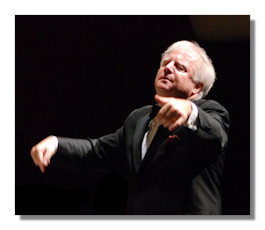
The Internet's Premier Classical Music Source
Related Links
- Latest Reviews
- More Reviews
-
By Composer
-
Collections
DVD & Blu-ray
Books
Concert Reviews
Articles/Interviews
Software
Audio
Search Amazon
Recommended Links
Site News
 Concert Review
Concert Review
Ludwig van Beethoven

The Symphonies, Program 4
- Overture "Coriolan" in C minor, Op. 62
- Symphony #2
- Symphony #7
Detroit Symphony Orchestra/Leonard Slatkin
Orchestra Hall, Detroit (16 February 2013)
An exuberant crowd gathered for the penultimate installment of the Detroit Symphony's 2013 Beethoven festival. Each of these concerts has shown steady improvement in both quality of ensemble and in the general understanding of Beethoven's idiom. While the first half of the program was a definite success, the great Seventh symphony was marred by what I felt was a legitimate interpretative misjudgment. Still, the overall excellence cannot be denied. Leonard Slatkin has really put the orchestra through its paces, with lively tempos that sometimes challenge his players. His embrace of modern scholarship regarding ensemble size and repeats has been equally engaging.
The first piece on the program was a perfect portrait of the festival as a whole; an urgently paced overture with superlative woodwind work, detailed strings, and decent brass playing. Certainly, this overture is Beethoven at his most darkly dramatic. There is no triumphant ending as in the overtures to Egmont and Fidelio. Rather, the brooding atmosphere is never entirely resolved. The DSO responded with gusto, and while I would have liked the attacks on notes to be a touch firmer, there was never a loss of tension or excitement. I have noted in a few previous reviews that the string section occasionally takes time to warm up. On this evening, they were superb.
This led into a remarkably satisfying performance of the Second symphony. It's not one of the great masterpieces, but Slatkin and his orchestra played as if it were. Full-bodied and alert playing, along with a fleet and nimble conception allowed the music to really come alive. In the wrong hands, this symphony simply isn't a lot of fun, with an awkwardly written third movement and a showy but equally shallow finale. It might also have the least drama of the Nine, being an even more sunny work than the more mature Eighth. Still, no cycle is complete without it, and it towers over many other Classical period symphonies. The DSO strings danced with precision and fullness of tone, dashing through their parts with a sense of excitement. More importantly, their blend was admirable and bode well for the Seventh that was to follow. Unfortunately, something went wrong.
The Seventh that concluded the program is another story altogether, one of the unquestioned masterpieces of the repertoire. In some ways it is also the musicians' Beethoven symphony; the score is a frequent study piece and lecture topic. It is also tremendously difficult to play, and unlike the Second that preceded it, requires a great deal of depth and careful thought in addition to great playing. The DSO already gave us outstanding renditions of the Fifth and Sixth, and so reasonably we could have expected a terrific Seventh as well. But here Slatkin made arguably his first major mistake of the festival.
A great performance of Beethoven's Seventh cannot simply rely on quality of ensemble. The piece requires balance, with a firm understanding of how each section of the orchestra relates to the next. Conductors as diverse as Arturo Toscanini and Bruno Walter have each recognized the need for each part to be carefully projected in this work. If you let the strings blanket everything, you get mush à la Karajan. Should you not pay enough attention to the lyrical aspect, you get a rowdy and crude interpretation à la Solti. Slatkin suffered from problems at both ends of the spectrum, in that his admittedly beautiful strings covered everything, and when other sections were asked to play out, they stuck out of the orchestral fabric like a sore thumb. Having reviewed both Herbert von Karajan and Georg Solti's recorded work here on Classical.net, it gave me no pleasure at all to hear an interpretation that preserved both the late conductors worst attributes.
This isn't all Slatkin's fault. The DSO strike damaged the brass and percussion sections of the orchestra, and they really struggled here. The horns, which had ranged from fair to excellent in the first three concerts, seemed to falter here. In a venue such as Orchestra Hall, that's not a problem you want to have, in this symphony of all pieces. The third movement scherzo suffered most from this mix of poor balance and playing, with some parts simply sounding bad. Although tempos were quick here, it wasn't at all light on it's feet, and with an audibly taxed wind and brass section, it wasn't enjoyable. The finale was better, audience reaction was positive, and I suspect most went home happy.
And it wasn't all bad; strings were incredible throughout the entire program, buoyant and crisply articulated. Third movement of the Seventh aside, my gushing praise of the winds remains undimmed. Finally, I should note that this string-heavy approach to the Seventh has sold millions of copies from very famous artists, and Solti's set is also being sold at the DSO gift shop. So whatever my reservations, the interpretive approach has merit, and the orchestra followed their maestro with obvious enthusiasm.
While this was by far the concert that validated my concerns about the festival most clearly, it remains a worthwhile installment. Although my feelings about the Seventh are not entirely positive, the festival itself has continued to revitalize the classical music scene in Detroit, something which transcends any of my complaints about interpretation. Certainly Leonard Slatkin's always musical insights and world-class cohorts promise to make the choral Ninth symphony every bit of the event it should be. Again, I am thrilled as a whole with the project, and I can't wait to be there as it concludes.
Copyright © 2013, Brian Wigman












